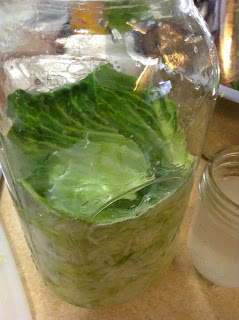I have been curious about fermenting for some time now. My science background unfortunately, has given me just enough knowledge to be paranoid about giving my family botulism, so I never attempted anything. Food preservation is something I've been dabbling in for several years - canning, freezing and dehydrating mainly. So why not pickling, fermenting, smoking, etc.? (Smoking is in the works.) I needed to do more research.
Sauerkraut seemed like a very basic place to start. Why did I even want to try this when I can buy it so readily? Well, it is just one more skill I wanted to learn. But do I go it alone? I just wasn't brave enough.
After chatting with a friend, I found out that our local family-owned organic market offers lots of different classes. In January I took their class on making Sauerkraut, which is part of their "Culture Club" Series. It was extremely easy to do and I was anxiously awaiting what I hoped would be the best kraut I had ever tasted. After 5 days, I unfortunately found mold growing around the caraway seeds that I had added.
Lesson #1: DO NOT ADD SEEDS!
Batch 1 with Caraway Seed.
Batch #2: Success!
Let's get fermenting!
Equipment needed:
Food grade container(s) (I use glass Ball jars)
Lid(s)
Weight (I use a jelly jar with salt water solution, you can also use CLEAN rocks, a plate, a baggie filled with water, etc. There are many options.)
Cabbage
Sea salt
Potato masher/Kraut Masher/Clean Hands
Optional: Airlock, crock, special fermenting jars
Step one is easy enough. Quarter the cabbage and remove the thick stem. Then shred the cabbage. If you have a mandolin, this works well. A sharp knife will give you nice thin slices. A food processor will lessen the work even further. How fine or course you like your kraut will depend on what you used to shred it.
For every 5 pounds of cabbage you will need 1 tablespoon of sea salt. If you don't have sea salt, any fine salt that is UN-iodized will work. Add the salt to the cabbage. Now for the elbow grease! With your hands you can mash and grind and squeeze the cabbage until liquid starts being released. You can also use a potato masher. Special wooden "kraut mashers" are available but rather costly. I use my hands - depending on the water content of the cabbage, this can go very quickly.
You can see the liquid at the bottom of the bowl.
Once you have a nice juicy mess, you need to start packing the cabbage down tightly into your vessel. I used large mouth Ball jars. (I splurged on a 1 gallon crock but haven't ventured that far yet!) My latest purchase was a set of special lids with airlocks. The airlock means I no longer have to remember to "burp" the jar to release the gases. Pack all the cabbage down to get rid of air pockets - they will allow for aerobic fermentation which is NOT what you want! - and until the brine (liquid) level is above the level of the cabbage.
Now that all of the cabbage is under the brine, you can put a nice big leaf on top. I found this helped keep the little pieces that float below the brine.
Once I was sure that everything was submerged, I added in a small jelly jar filled with a saline solution (a bit of kosher salt and water) as a weight. Making sure everything was still as I wanted it, and that the upper insides of the jar were free of debris, I added on my new cap with airlock. Any cabbage stuck to the sides above the brine are likely to mold! So I wipe down the sides as best I can. Any signs of mold for me is a "TOSS IT!" situation. There is no reason to risk it.
Jelly jar weight added.
Lid secured.
And now we wait. If you just use the regular canning lids, you will need to "burp" your jars daily. Do this by just loosening the ring until you hear the little hiss - do NOT remove the lid! You do not want to introduce air into this.
This batch was given about 5 days. After 3 or 4 days you can taste some to see how you like it. I like mine with a bit of bite. 5 days it was still a bit mild. By day 7 it was just right for me. I took off the airlock and took out the weight and large leaf. The whole jar with a new lid went into the fridge. Some people will leave theirs for weeks or even months! I have not gotten that brave. Next time I will fill the jar a bit more.
This batch was given about 5 days. After 3 or 4 days you can taste some to see how you like it. I like mine with a bit of bite. 5 days it was still a bit mild. By day 7 it was just right for me. I took off the airlock and took out the weight and large leaf. The whole jar with a new lid went into the fridge. Some people will leave theirs for weeks or even months! I have not gotten that brave. Next time I will fill the jar a bit more.
I have found that it will continue to ferment, albeit at a much slower rate, in the refrigerator so I must "burp" the jar every few days. I eat mine right out of the jar! Good for the probiotics. I also cooked some with some pork meatballs - it was just as delicious.
I am a total newbie at this, but I wanted to share my experiences so far. Sauerkraut was a great starter project for me. There is a ton of great information out there. Talk to friends who ferment. Look for local classes or get some books from the library.
I have moved on to my next fermenting adventure...brewing Kombucha Tea! (But more on that later...)
Happy Fermenting!
I am a total newbie at this, but I wanted to share my experiences so far. Sauerkraut was a great starter project for me. There is a ton of great information out there. Talk to friends who ferment. Look for local classes or get some books from the library.
I have moved on to my next fermenting adventure...brewing Kombucha Tea! (But more on that later...)
Happy Fermenting!









